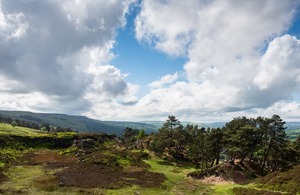|
The nature recovery projects, supported by £7.4 million funding from Defra and Natural England, are:
- East of Eden, Cumbria – Based in the upland regions of Cumbria, this project stretches over 100,000ha from fertile farmland of the eastern Eden Valley to the western slopes of the North Pennines and the moorlands above. The project will support land managers to create habitats for species such as the curlew, black grouse and the Teesdale Violet. Natural flood management techniques will reduce flood risk and improve the absorption of carbon by rewetting peat.
-
The Lost Wetlands, Cheshire to Lancashire – Extending over 5,000ha the project will reclaim, restore and rewet a mosaic of wetland habitats in South Greater Manchester and North Cheshire, previously lost to historic industrialisation, urbanisation and agricultural intensification of the landscape. A network of wetland habitats will be restored to improve connectivity for wildlife, creating habitats where dragonflies, great crested newts and water voles can thrive. The project will also engage young people and communities, providing greater connection to the wetlands on their doorstep and opportunities to celebrate the natural heritage of the area. This work will help support the government’s commitment to bring people closer to nature, with everyone living no more than 15 minutes from a green space.
-
Tees Estuary Recovering Nature, Northumbria – Covering over 11,000ha, the TERN Project will work with partners to improve, create and restore coastal, estuarine and land-based habitats. Steeped in industrial history, this area is home to a well-loved colony of common seals and assemblages of roosting waders and wildfowl including the little tern, wintering knot, ringed plover and redshank. Action will create bigger and better connected habitats that increase climate resilience and offer a sustainable future for these cherished species. New footpath links will also bring the community closer to nature, strengthening Teesside’s vision as a place for people and nature.
-
Heathlands Connections, Surrey – The project is working with partners to restore, enhance and connect rare lowland heathland habitat within the western section of the Surrey Hills AONB. It will connect the designated sites of Thursley, Hankley and Frensham Commons Special Protected Area with surrounding heathlands, covering an area of 16,000ha and creating a mosaic landscape that is rich in habitats for wildlife. The project will find collaborative solutions to challenges such as wildfire risk, habitat degradation and disturbance to ground nesting birds including the nightjar and Dartford warbler. Sustainable travel options for visitors are being developed, such as walking trails with train, bus and cycle connections to Frensham ponds, enabling local people to get closer to nature.
-
Bradford and South Pennines, Yorkshire and North Lincolnshire – Spanning 30,000ha, this partnership will restore and enhance the condition of the upland peat landscapes in the South Pennines, restoring habitats for moorland birds such as the endangered twite. Natural Flood Management techniques will benefit communities at risk of flooding in the Calder Valley with the creation of intertwining mosaics of wetland habitats. Green corridors will also be created, linking upland sites to the urban environment and industrial heartlands and allowing wildlife to move freely. The project will work closely with community groups and the NHS, providing opportunities to connect the people of Bradford and West Yorkshire with nature on their doorstep. Working with Bradford City of Culture 2025, the project will encourage sustainable access to nature and highlight the environmental links between the industrial heartlands of West Yorkshire and the moors which define them.
-
Seaford to Eastbourne, Sussex and Kent – Traversing 12,000 ha of the iconic land and seascape of the South Downs, the project builds on key partnerships with South East Water, local authorities, farmers and fishers. The project will build on research into chalk aquifers in the area which confirms the importance of using healthy chalk grass and chalk heath habitats to deliver clean and plentiful water. The work to integrate habitat and natural flood management schemes will create clean water supplies for nearby towns and benefit species, such as the rare wart-biter cricket. Ambitions further extend out to sea where the project partners will seek to boost short-snouted seahorse populations found near Beachy Head. The project is also researching how NHS staff who work in complex mental health can be trained in nature-based interventions, supporting the communities within Seaford to Eastbourne
Read full article
|
|


Add new comment